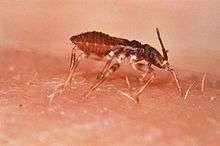Triatoma
Triatoma is a genus of assassin bug in the subfamily Triatominae (kissing bugs). The members of Triatoma (like all members of Triatominae) are blood-sucking insects that can transmit serious diseases, such as Chagas disease. Their saliva may also trigger allergic reactions in sensitive individuals, up to and including severe anaphylactic shock.[1]
| Triatoma | |
|---|---|
| (Left to right) Triatoma protracta, the most common species in the western U.S.; Triatoma gerstaeckeri, the most common species in Texas; Triatoma sanguisuga, the most common species in the eastern U.S. | |
| Scientific classification | |
| Kingdom: | |
| Phylum: | |
| Class: | |
| Order: | |
| Family: | |
| Subfamily: | |
| Genus: | Triatoma Laporte, 1832 |
| Species | |
|
See text. | |
Species
These are species according to reliable sources. While most species are found in the New World, a few are known from the Old World.[2][3][4][5] NOTE: The designation (Tc) signifies that the species is associated with Trypanosoma cruzi.
- Triatoma amicitiae Lent, 1951
- Triatoma arthurneivai Lent & Martins, 1940
- Triatoma bahiensis Sherlock & Serafim, 1967
- Triatoma baratai Carcavallo & Jurberg, 2000
- Triatoma barberi Usinger, 1939
- Triatoma bolivari Carcavallo, Martínez & Pelaez, 1984
- Triatoma boliviana Avendaño, 2007
- Triatoma bouvieri Larrousse, 1924
- Triatoma brailovskyi Martínez, Carcavallo & Pelaez, 1984
- Triatoma brasiliensis Neiva, 1911
- Triatoma breyeri Del Ponte, 1929, possible synonym of Mepraia breyeri
- Triatoma carcavalloi Jurberg, Rocha & Lent, 1998
- Triatoma carrioni Larrousse, 1926
- Triatoma cavernicola Else & Cheong, 1977
- Triatoma circummaculata (Stål, 1859)
- Triatoma costalimai Verano & Galvão, 1959
- Triatoma deaneorum Galvão, Souza & Lima, 1967
- Triatoma delpontei Romaña & Abalos, 1947
- Triatoma dimidiata (Latreille, 1811) (Tc) [important vector in parts of Mexico, Central America, Colombia and Ecuador].
- Triatoma dispar Lent, 1950
- Triatoma garciabesi Carcavallo, 1967
- Triatoma gerstaeckeri (Stål, 1859)
- Triatoma gomeznunezi Martínez, Carcavallo & Jurberg, 1994
- Triatoma guasayana Wygodzinsky & Abalos, 1949
- Triatoma guazu Lent & Wygodzinsky, 1979
- Triatoma hegneri Mazzotti, 1940
- Triatoma huehuetenanguensis Lima-Cordón, 2019 (Tc)
- Triatoma incrassata Usinger, 1939
- Triatoma indictiva Neiva, 1912
- Triatoma infestans (Klug, 1834)
- Triatoma jatai Gonçalves, 2013
- Triatoma juazeirensis Costa & Felix, 2007
- Triatoma jurbergi Carcavallo, Galvão & Lent, 1998
- Triatoma klugi Carcavallo, Jurberg, Lent & Galvão, 2001
- Triatoma lecticularia (Stål, 1859)
- Triatoma lenti Sherlock & Serafim, 1967
- Triatoma leopoldi (Schouteden, 1933)
- Triatoma limai Del Ponte, 1929
- Triatoma maculata (Erichson, 1848)
- Triatoma matogrossensis Leite & Barbosa, 1953
- Triatoma melanocephala Neiva & Pinto, 1923
- Triatoma mexicana (Herrich-Schaeffer, 1848)
- Triatoma migrans Breddin, 1903
- Triatoma mopan Dorn, 2018 (Tc)
- Triatoma neotomae Neiva, 1911
- Triatoma nigromaculata (Stål, 1872)
- Triatoma nitida Usinger, 1939
- Triatoma oliveirai (Neiva, Pinto & Lent, 1939)
- Triatoma patagonica Del Ponte, 1929
- Triatoma peninsularis Usinger, 1940
- Triatoma petrochiae Pinto & Barreto, 1925
- Triatoma pintodiasi Jurberg, Cunha & Rocha, 2013
- Triatoma platensis Neiva, 1913
- Triatoma protracta (Uhler, 1894) (western conenose)
- Triatoma pseudomaculata Correa & Espínola, 1964
- Triatoma pugasi Lent, 1953
- Triatoma recurva (Stål, 1868)
- Triatoma rubida (Uhler, 1894)
- Triatoma rubrofasciata (De Geer, 1773)
- Triatoma rubrovaria (Blanchard, 1843)
- Triatoma ryckmani Zeledón & Ponce, 1972
- Triatoma sanguisuga (Leconte, 1856) (eastern blood-sucking conenose)
- Triatoma sherlocki Papa, Jurberg, Carcavallo, Cerqueira & Barata, 2002
- Triatoma sinaloensis Ryckman, 1962
- Triatoma sinica Hsiao, 1965
- Triatoma sordida (Stal, 1859)
- Triatoma tibiamaculata (Pinto, 1926)
- Triatoma vandae Carcavallo, Jurberg, Rocha, Galvão, Noireau & Lent, 2002
- Triatoma venosa (Stal, 1872)
- Triatoma vitticeps (Stål, 1859)
- Triatoma williami Galvão, Souza & Lima, 1965
- Triatoma wygodzinskyi Lent, 1951
Fossil taxa:
- †Triatoma dominicana Poinar, 2005
gollark: Yes, multiculting is cool and good™.
gollark: ↓ FEAR it
gollark: You should worship Rust/Ferris, actually.
gollark: Applied memetics.
gollark: Tomorrow is merely Thursday 2.04 beta, yes.
References
- "Triatomine Bug FAQs". Centers For Disease Control And Prevention: Parasites - American Trypanosomiasis (also known as Chagas Disease). 2016-09-07. Retrieved 2016-09-15.
Could I be allergic to the bite of a triatomine bug? -- Yes. The saliva of certain types of triatomines can cause an allergic reaction in some people. An allergic reaction may be characterized by severe redness, itching, swelling, welts, hives, or, rarely, anaphylactic shock (severe allergic reaction). ... It is important to note that not all triatomines are infected with the parasite even though they may cause an allergic reaction.
- Gorla, D.E.; Dujardin, J.P.; Schofield, C.J. (1997). "Biosystematics of Old World Triatominae". Acta Tropica. 63: 127–140. doi:10.1016/s0001-706x(97)87188-4.
- Galvão, Cleber; Carcavallo, Rodolfo; da Silva Rocha, Dayse; Jurberg, José (2003). "A checklist of the current valid species of the subfamily Triatominae Jeannel, 1919 (Hemiptera, Reduviidae) and their geographical distribution, with nomenclatural and taxonomic notes". Zootaxa. 202: 1–36. doi:10.11646/zootaxa.202.1.1.
- Lima-Cordón, Raquel Asunción; Monroy, María Carlota; Stevens, Lori; Rodas, Antonieta; et al. (2019). "Description of Triatoma huehuetenanguensis sp. n., a potential Chagas disease vector (Hemiptera, Reduviidae, Triatominae)". ZooKeys. Pensoft (820): 51–70. doi:10.3897/zookeys.820.27258. PMC 6361876. PMID 30728739.
- Dorn, Patricia L.; Justi, Silvia A.; Dale, Carolina; Stevens, Lori; et al. (2018). "Description of Triatoma mopan sp. n. from a cave in Belize (Hemiptera, Reduviidae, Triatominae)". ZooKeys. Pensoft (775): 69–95. doi:10.3897/zookeys.775.22553. PMC 6058004. PMID 30057472.
External links
- Information on Triatoma infestans and other members of Triatominae, by Andreas Rose
- ECLAT, European Community Latin American Network for Research on the Biology and Control of Triatominae
- more external links see: Triatominae
This article is issued from Wikipedia. The text is licensed under Creative Commons - Attribution - Sharealike. Additional terms may apply for the media files.
